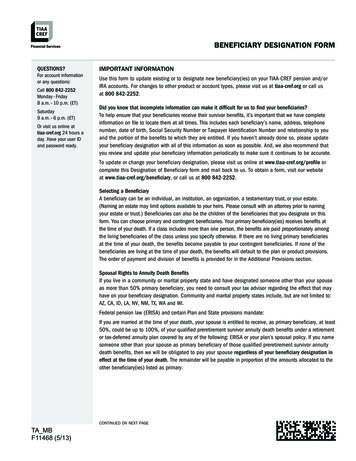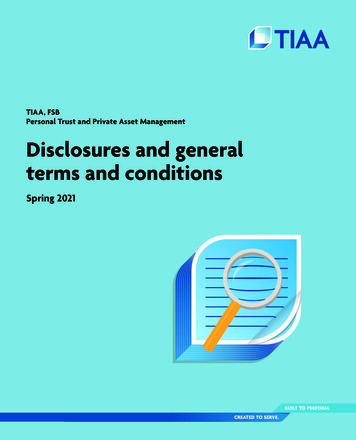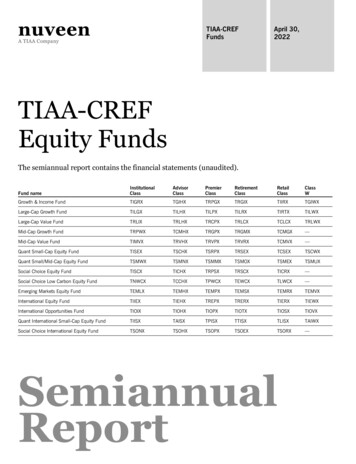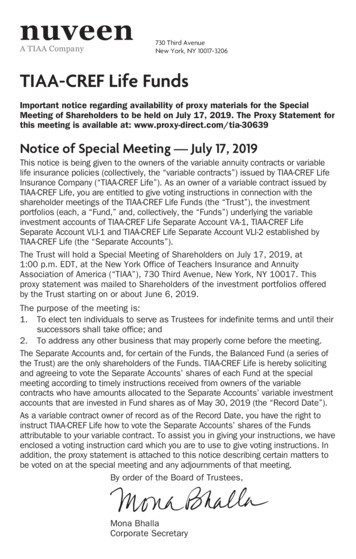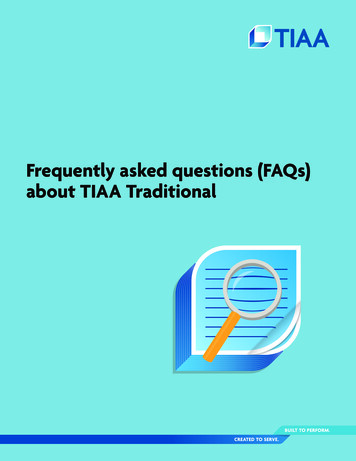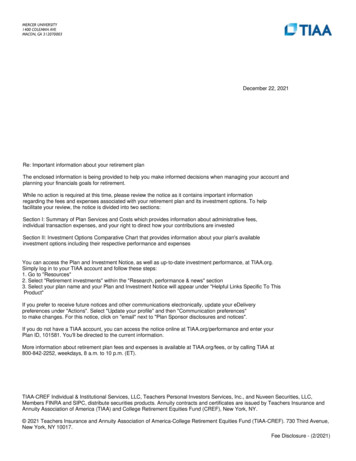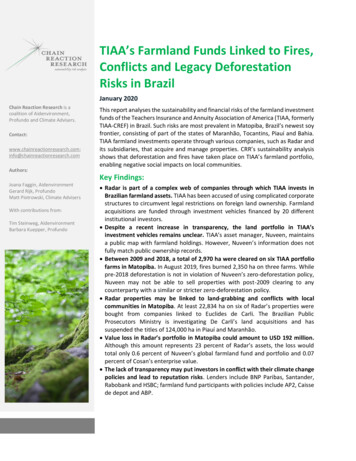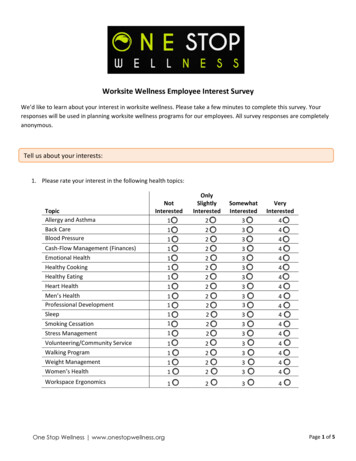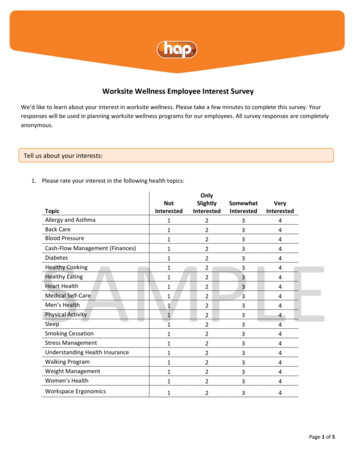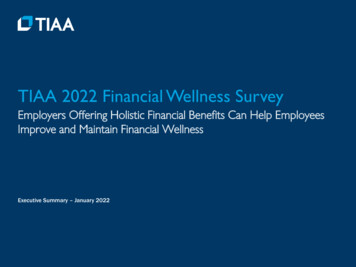
Transcription
TIAA 2022 Financial Wellness SurveyEmployers Offering Holistic Financial Benefits Can Help EmployeesImprove and Maintain Financial WellnessExecutive Summary – January 2022
When it comes to overall financial wellness, many Americans still feelchallenged on multiple fronts7 in 10 have a budget, just25% follow a detailed budget.38% have a writtenfinancial plan.Only 16% have financial planscreated by a professional78% say they have an emergencyfund; less than ½ say they cancover 6 months of expenses20% with high financial wellnesscould not easily cover 6 monthsof expenses59% report some or a great dealof stress regarding their financesOnly 28% currently work witha financial professional.2
When defining financial wellness, many agree it means feelingcomfortable with one’s financial situationAmericans define financial wellness as simply feeling comfortable with theirfinancial situation. Over 50% believe wellness is defined as having themeans to take care of family, not worrying about money or debt, and feelingprotected financially from life’s unexpected events.How Americans Define Financial WellnessFeeling comfortable with your financialsituationHaving the means to take care of family andothers61%53%Not worrying about money or debts51%Feeling protected financially from unexpectedevents51%A good understanding of your finances48%Being able to afford the lifestyle you want46%Not feeling held back in life by moneyKnowing you'll never run out of money inretirementBeing able to donate time or money tocauses39%36%27%3
Very few believe they’re financially well. Men, wealthy, older, and retiredindividuals are likely to have higher self-ratingsSelf-Rating of Financial WellnessHigh financialwellness12%11%Net high(9–10)22%17%On a scale from 1 to 10, 22% rate theirfinancial wellness highly (a 9 or 10).A similar share rates their wellnessas low (21% with a 1 to 4 rating).16%12%Individuals more likely to have higher wellnessratings include older Americans, men, retirees,and those with higher income and savings.12%Low financialwellness8%5%3%5%Net low(1–4)21%4
Even among those with high financialwellness scores, there are gaps inplanning and emergency savings.Despite Americans generally rating their financial wellness positively,there are areas of concern:1. Planning While seven in 10 Americans have a budget, just a quarter follow a detailed budget. 38% have a written financial plan and only 16% have plans created by a professional. Just 28% currently work with a financial professional. Even among those with “high financial wellness,” only 39% have a detailed budget,35% have a written plan from an advisor, and half are working with a financialprofessional.2. Emergency Savings In total, a large majority (78%) say they have an emergency fund. But these fundsappear inadequate, as less than half say they can cover six months of expensesshould they lose their job or income source. 20% of those with high financial wellness could not easily coversix months of expenses.3. Stress Six in 10 Americans report some or a great deal of stress when it comes to theirfinances. Especially worrisome, is that budgeters are more likely to report financial stress (eventhough those with high financial wellness are more likely to budget).25% have a detailedbudget and 16%have a written planfrom an advisor28% work witha financialprofessional45% can coversix monthsexpensesshould theylose their jobor incomesource.59% arestressed abouttheir finances5
The financial pandemic has further underscoredthe importance and meaning of wellness51%of all Americans arenow more aware oftheir overall financialwellness since thepandemicAs a result of the pandemic:51%37%say their financialwellness increased42%say it stayed the same3 in 103 in 10 prioritizehaving anemergency fundmore now than theydid since thepandemic beganIncreasedawareness ofoverall financialwellnessOver the last 2 years,39%Changed theirdefinition offinancialwellness21%Report a decrease6
Over six in 10 think employers have a responsibility to ensureemployees are mentally well and healthy. Just half say the same aroundfinancial wellness.Sentiment Around Employers’ ResponsibilityStrongly agreeSomewhat agreeNeither agree nor disagreeSomewhat disagreeStrongly disagreeNet Agree: 63%Employers have a responsibility to make sureemployees are mentally healthy and emotionally well30%33%25%8%3%Net Agree: 61%Employers have a responsibility to make sureemployees are healthy and physically well28%34%26%8%4%Net Agree: 51%Employers have a responsibility to help employeesimprove/maintain their financial wellness21%31%33%10% 6%7
Employer financial wellness programs appear to help ease moneyconcerns of AmericansWorkers who have participatedin a wellness program aretwice as likely to have a highfinancial wellness rating thanthose who are not offeredresources or who do notparticipate (32% vs. 15%)WellnessParticipantsNotParticipating92%of those with high financial wellnessscores report understanding theirplan extremely or very well39%with low financial wellness scoresreport understanding their planextremely or very well32% have ahigh financialwellness rating54% are confidentthey will retire whenthey want54% are confident theywill afford the retirementlifestyle they want50% are confidentthey will not run outof moneyvs.vs.vs.vs.15% have ahigh financialwellness rating32% are confidentthey will retire whenthey want29% are confident theywill afford the retirementlifestyle they want29% are confidentthey will not run outof money8
People with higher financialwellness scores are willing to putmore money towards retirementIf given an additional 200 a month, nonretired Americans would put an average of60% towards their retirement savings. Thisincreases to 71% among those who ratetheir financial wellness higher (vs. 45% ofthose with low financial wellness)Those with higher financial wellness arealso already more likely to have retirementsavings and to be contributing to anemployer retirement plan.If Had an Additional 200 Monthly, AveragePortion Put Towards Retirement Savings60%Total45%63%71%Low FinancialWellnessModerateFinancialWellnessHigh FinancialWellness9
However, only about half ofworkers receive financial wellnessresources from their employer55% of workers report employerassistance on financial wellness aseither a standalone resource or aspart of a financial wellness program.36% say they receive more than onefinancial wellness resource. The most common area thatworkers say their employer offersassistance is saving forretirement, but even this is onlyreported by 31%.45% of workers say they receivewellness resources other thansaving for retirement.Financial Wellness Resources at WorkAmong Workers20%Saving for retirement31%Managing healthcare costs7%How to build up an emergency fund7%14%5%14%Choosing/monitoring investments16%8%Information on GLI in retirement14%Debt management/coaching4%Saving for education6%12%How to improve your credit score6%11%Managing bills and spending5%11%Managing student loan debt3%Used13%9%Offered10
And even when offered, many resources appear underutilizedUtilization and engagement with benefitscould also be stronger. Usage of offeredresources hovers around 50%, except forsaving for retirement (65% of those offered,or 20% of all workers). Other higher used resources includeinformation on guaranteed income (56%),how to improve credit score (54%), andsaving for education expenses (52%). Investment help and debt/student debthelp is used by about a third of thoseoffered the assistance.11
Younger workers are moreeager than other generationsfor financial wellness benefits;however, barriers persistGen Z and Millennials ranked morelikely to be interested in each typeof wellness resource.Top barriers to engaging with employerwellness programs include: Concerns about hidden costs Not wanting to disclose their finances 40% of Gen Z do not want todisclose, which is DOUBLE thatof other generations2/3 of Gen Z believe employershave a responsibility to helpimprove or maintain theiremployees’ financial wellness.Concerns with ReceivingHelp with Financial Wellnessfrom EmployerWorried about hidden costs orfees27%Don't want to disclosefinances/issues to employer25%Wouldn't be as effective asofferings you could find on own20%Don't think offerings wouldmake a difference17%You are not confident you knowwhere to go for help17%Offerings do not address yourspecific needs or situationDon't trust your employer15%8%12
There is a major shift underway inexpectations of an employer’sresponsibility for their employees’wellness. Gen Z is leading the way.Younger Americans are more likely to believe that employers have a responsibilityto help their employees be well mentally, physically, and financially. In fact, two-thirds of Gen Z believe employers have a responsibility to helpimprove or maintain their employees' financial wellness.These expectations of employers may be driven in part by need. Gen Z is more likely to give themselves a lower financial wellness rating thanother generations (Millennials, for example, rate similarly to Gen X). Gen Z is also the most likely to think their financial wellness is worse thanpeople in their parents’ generation when they were their age.Yet Gen Z does not have a defeatist attitude. As mentioned earlier, they show themost interest and engagement in employer wellness resources. And thisengagement can help. Gen Z workers who are participating in financial wellnessprograms: Have a high financial wellness score (25% vs. 3% of those not offered/notparticipating). Are more likely to say their wellness is better than others in their generation. Have more retirement confidence. Are more likely to have taken action to improve their wellness on one or moreissues, including retirement-related improvements.Employers’ ResponsibilityMake sureemployees arementally healthyand emotionallywell66%72%66%56%44%Make sureemployees arehealthy andphysically well72%70%61%54%40%Help employeesimprove/maintain their financialwellnessGen ZGen XSilent65%61%52%41%29%MillennialsBoomers13
Disclosures and MethodologyThis material is for informational or educational purposes only and does not constitute fiduciary investment advice under ERISA, asecurities recommendation under all securities laws, or an insurance product recommendation under state insurance laws orregulations. This material does not consider any specific objectives or circumstances of any particular investor or suggest any specificcourse of action. Investment decisions should be made based on the investor’s own objectives and circumstances.TIAA-CREF Individual & Institutional Services, LLC, Member FINRA, distributes securities products. Annuity contracts and certificatesare issued by Teachers Insurance and Annuity Association of America (TIAA) and College Retirement Equities Fund (CREF), New York,NY. Each is solely responsible for its own financial condition and contractual obligations. 2022 Teachers Insurance and Annuity Association of America-College Retirement Equities Fund, 730 Third Avenue, New York, NY10017The 2022 TIAA Financial Wellness Survey was conducted online from Oct. 22 to Nov. 3, 2021 surveying 3,008 Americans ages 18 andover on a broad range of financial management issues and topics.195161514
Despite Americans generally rating their financial wellness positively, there are areas of concern: 1. Planning While seven in 10 Americans have a budget, just a quarter follow a detailed budget. 38% have a written financial plan and only 16% have plans created by a professional. Just 28% currently work with a financial professional.
